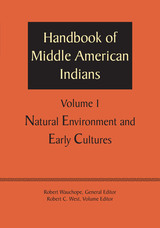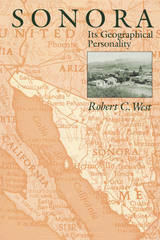
This is the first volume of the monumental Handbook of Middle American Indians, a definitive encyclopaedia of the environment, archaeology, ethnology, social anthropology, ethnohistory, linguistics, and physical anthropology of the native peoples of Mexico and Central America. The Handbook was published in cooperation with the Middle American Research Institute of Tulane University under the general editorship of Robert Wauchope (1909–1979). This volume of the Handbook was edited by Dr. Robert C. West (1913–2001), Boyd Professor of Geography at Louisiana State University, an outstanding authority on Latin America. He was formerly cultural geographer for the Smithsonian Institution.
Included in this first volume are chapters written by leading authorities in various fields of the natural and social sciences that are concerned with the natural environment of Middle America, its role in the shaping of Indian cultures, the earliest primitive hunters of this area, the beginnings of agriculture, and the broad patterns of prehistoric civilizations there.
There are articles on the geohistory and paleogeography of Middle America, its surface configuration and associated geology, hydrography, the American Mediterranean, oceanography and marine life along the Pacific coast, weather and climate, natural vegetation, the soils and their relation to the Indian peoples and cultures, fauna , the natural regions of Middle America, the primitive hunters, the food-gathering and incipient agricultural stage of prehistoric Middle America, origins of agriculture there, and the patterns of farming life and civilization.
The Handbook of Middle American Indians was assembled and edited at the Middle American Research Institute of Tulane University with the assistance of grants from the National Science Foundation and under the sponsorship of the National Research Council Committee on Latin American Anthropology.

A land where some streams ran with gold. A landscape nearly empty of inhabitants in the wake of Apache raids from the north. And a former desert transformed by irrigation into vast fields of wheat and cotton. This was and is the state of Sonora in northwest Mexico.
In this cultural historical geography, Robert C. West explores the dual geographic "personality" of this part of Mexico's northern frontier. Utilizing the idea of "old" and "new" landscapes, he describes two Sonoras—to the east, a semiarid to subhumid mountainous region that reached its peak of development in the colonial era and still lives largely in its colonial past; and, to the west, a desert region that in the twentieth century has become a major agricultural producer and the modern center of economic and cultural activity.
After a description of the physical and biotic aspects of Sonora, West describes the aboriginal farming cultures that inhabited eastern Sonora before the Spanish conquest. Following the conquest, he traces the spread of Jesuit missions and Spanish mining and ranching communities into this land where gold, silver, and copper ores were easily extracted by surface mining. He charts the decline of eastern Sonora with the coming of Apache and Seri raids during the eighteenth and nineteenth centuries. And he shows how western Sonora has become one of Mexico's most powerful political and economic entities in the twentieth century.
For geographers, historians, anthropologists, and economists, as well as travelers to Sonora and its coastal resorts, this lively and interesting book will be important reading.
READERS
Browse our collection.
PUBLISHERS
See BiblioVault's publisher services.
STUDENT SERVICES
Files for college accessibility offices.
UChicago Accessibility Resources
home | accessibility | search | about | contact us
BiblioVault ® 2001 - 2024
The University of Chicago Press









